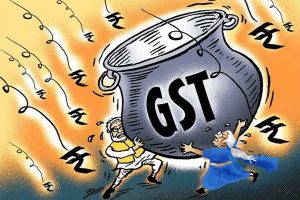GST Council likely to meet early Jan; may discuss rate rationalisation

The Centre is looking to convene a meeting of the all-powerful Goods and Service Tax Council in early January.
The meeting is likely to focus on rectifying the inverted duty structure for a few more items and will also serve as a platform for pre-Budget discussions between Union Finance Minister Nirmala Sitharaman and state finance ministers, Business Standard has learnt.
“The current Winter Session of Parliament ends on December 23, followed by the Christmas-New Year period.
“After that we would like to have a meeting of the GST Council, depending on whether there can be a quorum,” a top government official said.
In the meeting, Sitharaman and senior Budget-makers, including Revenue Secretary Tarun Bajaj, are likely to take views of state finance ministers on their expectations from the 2022-23 Union Budget.
Officials said that a decision is yet to be taken on which items will be considered for rate rationalisation; the Group of Ministers formed to review the matter has not yet submitted its report.
Industry body representatives, on the other hand, said that rates of some pharmaceutical products need to be rectified, especially those in the 5 or 12 per cent bracket whose input materials are taxed higher.
“Some pharmaceutical products and tractors still come under the inverted duty structure,” said Ajmer Singh Bisla, senior advisor-indirect taxation, Confederation of Indian Industries.
While most vehicles, including heavy-duty ones, are taxed in the 28 per cent bracket, some tractors with engine capacity of less than 1800 cc are in the 12 per cent category.
The government official quoted above also said that there had been representation from fertiliser manufacturers on inverted duty structure.
However, the view in the government is that tinkering with products like fertilisers and tractors can be politically sensitive, lest elimination of inverted duty structure leads to an increase in GST rates of the finished products.
Hence, a considered view will be taken on products linked to the agriculture sector.
At the 45th GST Council Meeting in Lucknow on September 17, the Council had decided to rectify the inverted duty structure for footwear and textiles.
Subsequently, the rate for footwear and textiles of any value was raised to 12 per cent, effective from January 1, 2022.
Earlier, the GST rate was 5 per cent for sale value of up to Rs 1,000 per piece in the case of apparels and per pair in the case of footwear.
While experts hailed the move, a section of the clothing industry decried it, saying that only a small group of the sector had an inverted duty structure.
Though there were reports that the GoM had met on November 27 to finalise its report based on the fitment committee’s recommendations, the official quoted above said the report on rate rationalisation is yet to be finalised.
At the Lucknow meeting, the Council set up two GoMs.
One group was tasked with suggestions on rationalising rates and correction of inverted duty structure, and was led by Karnataka Chief Minister Basavaraj Bommai.
The other group was tasked with recommending ways to review IT systems, potential sources of evasion, and data analyses in order to expand the tax base and maximise returns.
This GoM is headed by Maharashtra Deputy Chief Minister Ajit Pawar.
Both these reports are expected to be finalised before the next meeting.
A couple of weeks ago, industry body PHD Chamber of Commerce and Industry had urged the GST Council to rationalise rates, stating that the current rates are not in sync with the demand creation and employment generation in the country.
Source: Read Full Article

